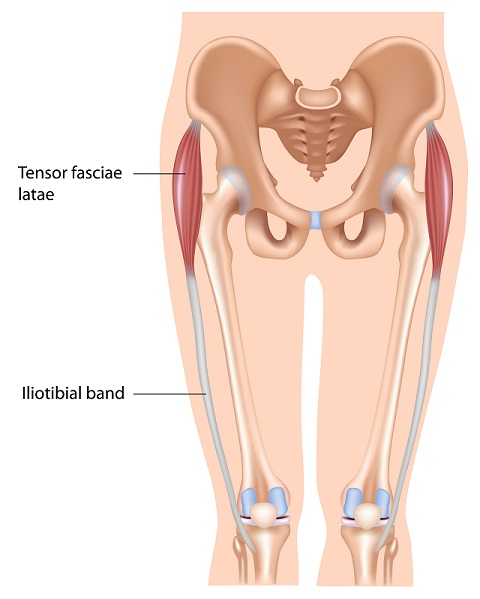With the hotter months approaching, a lot of people are getting out and being active again. This is great – we highly encourage physical activity!
One common injury during this time is iliotibial band friction syndrome (known as ITBFS, ITBS, or simply IT band syndrome). We see it very regularly in our physical therapy treatment clinics. Below is an explanation of ITBS and a few exercises to help at home.
Who is most at risk for ITB syndrome?
Athletes, runners (especially distance runners), and people who are new to exercise tend to be the most at risk for this common condition. Although it is not known what the exact cause is, the syndrome tends to develop with repetitive movement. When movement patterns are being formed, or muscle strength is still being built, the instance of this condition increases.
This can be from overuse, repetitive exercise, or muscle tightness. The constant motion as the knee bends and straightens creates friction over the muscles leading to inflammation and pain in the side of the knee and hip.
Taking a look at the anatomy of the IT band
The IT band is simply a long strip of fascia (a type of connective tissue) that originates of the hip bone and extends down to the tibia, past the knee. On the hip it connects to the crest of the pelvis via the gluteal muscles and a smaller hip muscle known as the tensor fascia latae via connective tissues (another common location of pain from ITBS). Referring to the image below, it is no secret why it hurts where it does – complaints of sharp pain to the hip or knee are part and parcel to ITB syndrome. This pain can often be debilitating to the point that runners with iliotibial band syndrome find it nearly impossible to exercise at all – not good!

Symptoms: Most common symptoms are pain on the outside (lateral) part of the knee, a pulling, burning, or snapping sensation on the outside side of your thigh (this can be ligament tightness, and can present many ways), or even pain on the outside of your hip.
Steps to relieve IT band syndrome
The first thing is to relax and take it easy. If you are exercising or running a lot, it may be time to take a break. As mentioned above, IT Band syndrome is inflammation of the tissues. The BEST way to decrease inflammation is to rest, ice the area, and take NSAID’s (after consulting with your doctor). This should be done in conjunction with some gentle stretching and muscle strengthening activity.
After 3-5 days, if the inflammation is starting to subside, add some exercises / stretches into your routine to help alleviate the pain. Here are some easy and effective exercises:
Hamstring Stretch
- Can use a belt, stretching strap, or dog leash.
- With one leg straight, and the other one bent at 90 degrees, Place loop around foot with leg straight and pull strap straight back toward you until you feel a gentle stretch in the back of your leg.
- Hold the stretch for 30 seconds and repeat three times.
IT Band Stretch
- Can use a belt, stretching strap, dog leash.
- Place loop around foot with leg straight and pull strap straight back toward you until you feel a gentle stretch in the back of your leg.
- With your other leg flat on the ground, gently guide your stretching leg across midline by pulling your stretch strap until you feel a gentle stretch down the outside of your thigh into your knee.
- Hold for 30 seconds and repeat three times.
Foam rolling IT Band
- One of the benefits of foam rollers is that they are inexpensive and can be found online or in most sporting goods stores.
- Lay on down on your side, on the foam roller with the foam roller on the outside of your thigh.
- Use your other leg, and forearm to leverage yourself and slowly roll back and forth to get the full length of your IT Band.
- Roll the area for 20-30 seconds and repeat three times.
Massage Roll the IT Band
- This is like the foam rolling above, but if you have trouble getting onto the ground, or find foam rolling painful, you can try a massage stick. It is a little easier to control the amount of pressure applied.
- They can be found online or in fitness stores.
- The best way to use this is to lay down on your side and get someone to help you out. You can relax while someone else does the work!
- Make sure you communicate to the person helping you about the pressure they are applying, as the IT Band can be very sensitive. Start out with light pressure, and you can tell them to apply a stronger pressure when you feel comfortable. Its just like using a rolling pin, but make sure they go slow!
- Massage the area for 20-30 seconds and repeat three times.
What to do if ITBS symptoms persist
Like a lot of forms of tendonitis, this problem should clear up in a few weeks. If you are having a lot of pain and these DIY physical therapy exercises are not helping, we advise that you check with your doctor or physical therapist. These stretches are a good place to start – and we hope they clear up your issue. However, if your problem is chronic (read, three or more months of pain), or if the pain is severe, you will be best served by a consultation with a medical clinician or physical therapist. As always, we do recommend that you are medically cleared for exercise before implementing these exercises into your daily routine. Good luck!

















